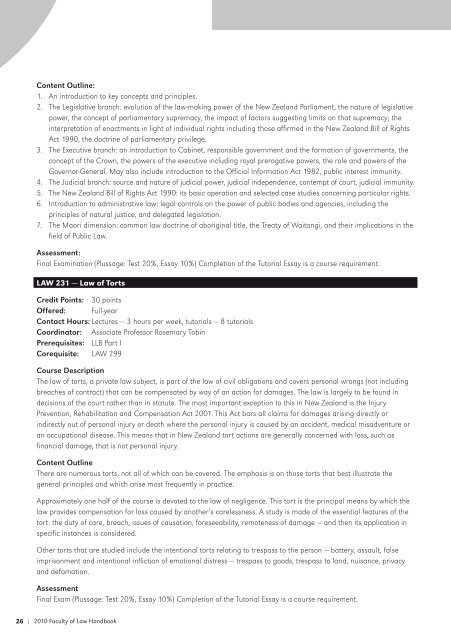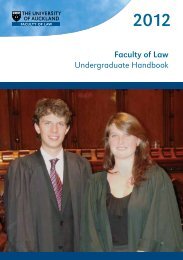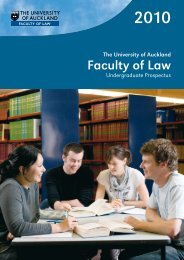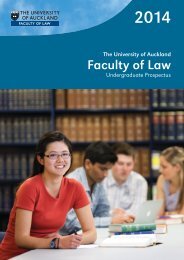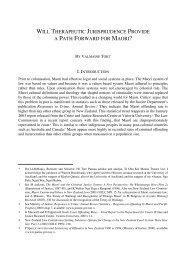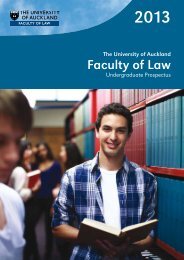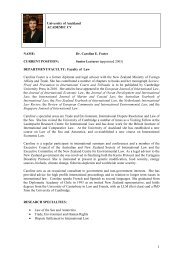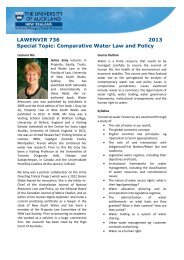Faculty of Law Undergraduate Handbook - Faculty of Law - The ...
Faculty of Law Undergraduate Handbook - Faculty of Law - The ...
Faculty of Law Undergraduate Handbook - Faculty of Law - The ...
- No tags were found...
Create successful ePaper yourself
Turn your PDF publications into a flip-book with our unique Google optimized e-Paper software.
Content Outline:1. An introduction to key concepts and principles.2. <strong>The</strong> Legislative branch: evolution <strong>of</strong> the law-making power <strong>of</strong> the New Zealand Parliament, the nature <strong>of</strong> legislativepower, the concept <strong>of</strong> parliamentary supremacy, the impact <strong>of</strong> factors suggesting limits on that supremacy; theinterpretation <strong>of</strong> enactments in light <strong>of</strong> individual rights including those affirmed in the New Zealand Bill <strong>of</strong> RightsAct 1990, the doctrine <strong>of</strong> parliamentary privilege.3. <strong>The</strong> Executive branch: an introduction to Cabinet, responsible government and the formation <strong>of</strong> governments, theconcept <strong>of</strong> the Crown, the powers <strong>of</strong> the executive including royal prerogative powers, the role and powers <strong>of</strong> theGovernor-General. May also include introduction to the Official Information Act 1982, public interest immunity.4. <strong>The</strong> Judicial branch: source and nature <strong>of</strong> judicial power, judicial independence, contempt <strong>of</strong> court, judicial immunity.5. <strong>The</strong> New Zealand Bill <strong>of</strong> Rights Act 1990: its basic operation and selected case studies concerning particular rights.6. Introduction to administrative law: legal controls on the power <strong>of</strong> public bodies and agencies, including theprinciples <strong>of</strong> natural justice, and delegated legislation.7. <strong>The</strong> Maori dimension: common law doctrine <strong>of</strong> aboriginal title, the Treaty <strong>of</strong> Waitangi, and their implications in thefield <strong>of</strong> Public <strong>Law</strong>.Assessment:Final Examination (Plussage: Test 20%, Essay 10%) Completion <strong>of</strong> the Tutorial Essay is a course requirement.LAW 231 — <strong>Law</strong> <strong>of</strong> TortsCredit Points: 30 pointsOffered: Full-yearContact Hours: Lectures — 3 hours per week, tutorials — 8 tutorialsCoordinator: Associate Pr<strong>of</strong>essor Rosemary TobinPrerequisites: LLB Part ICorequisite: LAW 299Course Description<strong>The</strong> law <strong>of</strong> torts, a private law subject, is part <strong>of</strong> the law <strong>of</strong> civil obligations and covers personal wrongs (not includingbreaches <strong>of</strong> contract) that can be compensated by way <strong>of</strong> an action for damages. <strong>The</strong> law is largely to be found indecisions <strong>of</strong> the court rather than in statute. <strong>The</strong> most important exception to this in New Zealand is the InjuryPrevention, Rehabilitation and Compensation Act 2001. This Act bars all claims for damages arising directly orindirectly out <strong>of</strong> personal injury or death where the personal injury is caused by an accident, medical misadventure oran occupational disease. This means that in New Zealand tort actions are generally concerned with loss, such asfinancial damage, that is not personal injury.Content Outline<strong>The</strong>re are numerous torts, not all <strong>of</strong> which can be covered. <strong>The</strong> emphasis is on those torts that best illustrate thegeneral principles and which arise most frequently in practice.Approximately one half <strong>of</strong> the course is devoted to the law <strong>of</strong> negligence. This tort is the principal means by which thelaw provides compensation for loss caused by another’s carelessness. A study is made <strong>of</strong> the essential features <strong>of</strong> thetort: the duty <strong>of</strong> care, breach, issues <strong>of</strong> causation, foreseeability, remoteness <strong>of</strong> damage — and then its application inspecific instances is considered.Other torts that are studied include the intentional torts relating to trespass to the person — battery, assault, falseimprisonment and intentional infliction <strong>of</strong> emotional distress — trespass to goods, trespass to land, nuisance, privacyand defamation.AssessmentFinal Exam (Plussage: Test 20%, Essay 10%) Completion <strong>of</strong> the Tutorial Essay is a course requirement.26 | 2010 <strong>Faculty</strong> <strong>of</strong> <strong>Law</strong> <strong>Handbook</strong>


